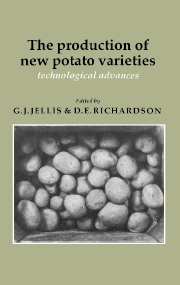Book contents
- Frontmatter
- Contents
- List of contributors
- Preface
- Editors' note and acknowledgements
- Introduction
- The development of potato varieties in Europe
- Genetic Resources
- Breeding Strategies
- Potato breeding strategy in the German Democratic Republic
- Potato breeding strategy in the Federal Republic of Germany
- Potato breeding strategy in the Netherlands
- Potato breeding strategy in Poland
- Potato breeding strategy in the United Kingdom
- Private potato breeding in the United Kingdom
- Selection and Screening Methods
- Variety Assessment
- Semi-conventional Breeding Methods
- True Potato Seed
- Unconventional Breeding Methods
- Commentary
- Index
Potato breeding strategy in the Netherlands
Published online by Cambridge University Press: 05 March 2012
- Frontmatter
- Contents
- List of contributors
- Preface
- Editors' note and acknowledgements
- Introduction
- The development of potato varieties in Europe
- Genetic Resources
- Breeding Strategies
- Potato breeding strategy in the German Democratic Republic
- Potato breeding strategy in the Federal Republic of Germany
- Potato breeding strategy in the Netherlands
- Potato breeding strategy in Poland
- Potato breeding strategy in the United Kingdom
- Private potato breeding in the United Kingdom
- Selection and Screening Methods
- Variety Assessment
- Semi-conventional Breeding Methods
- True Potato Seed
- Unconventional Breeding Methods
- Commentary
- Index
Summary
INTRODUCTION
From the title, the reader of this chapter may expect to get the formula for the Dutch breeders' success. However, there never has been a specific breeding strategy formulated by the fundamental breeders although, in the past, possibilities for future work have been published (Dorst 1963; Anon. 1980). The viewpoint put forward in this paper is that of a practical breeder, and so runs the risk of being one-sided.
The paper has been divided into two sections:
a. the past, because this has led to current achievements,
b. the future, what is desirable and what new opportunities will there be?
THE PAST
Potato breeding in the Netherlands has now been practised for about a century. In that period breeding has developed into a fully-fledged profession. Nevertheless, the basic principles of breeding are still the same - creating variation and selection.
The beginning in the Netherlands
There was no obvious date when breeding commenced. In several countries, during the whole of the last century, naturally produced true seed was grown to prevent degeneration. This slowly evolved into purposeful crossing (Sneep 1968). In the Netherlands the work of G. Veenhuizen in 1888 is considered to be the start of potato breeding. His great influence is described by De Haan (1958).
- Type
- Chapter
- Information
- The Production of New Potato VarietiesTechnological Advances, pp. 45 - 54Publisher: Cambridge University PressPrint publication year: 1987
- 3
- Cited by

